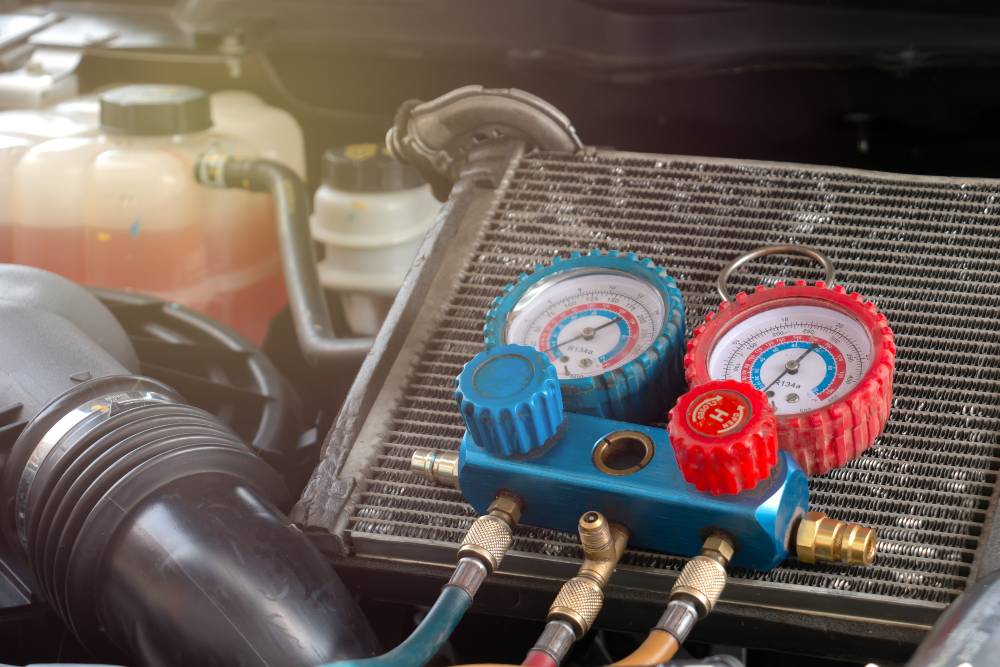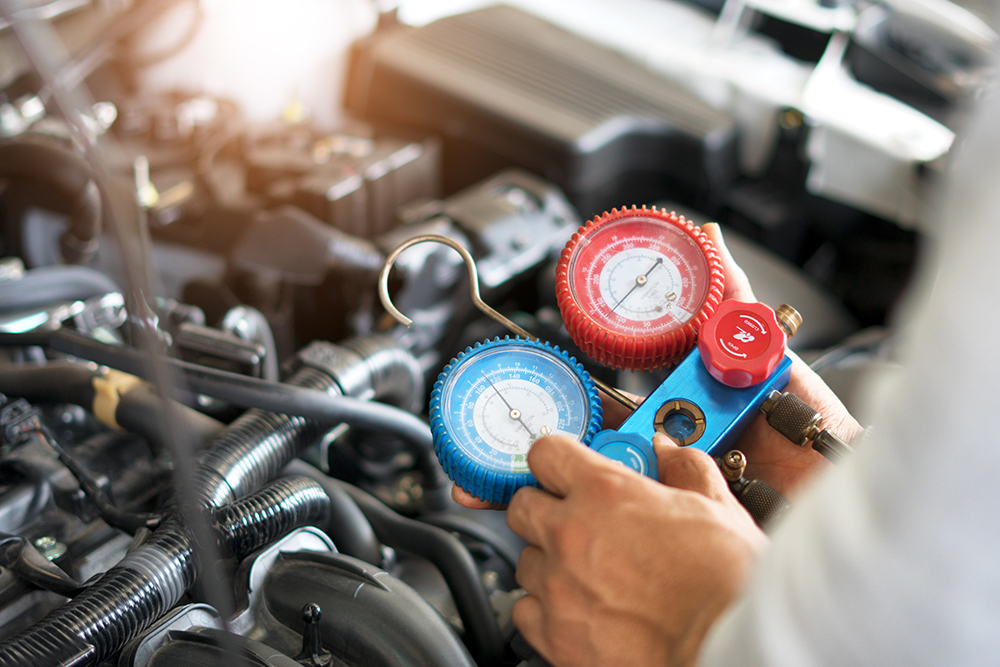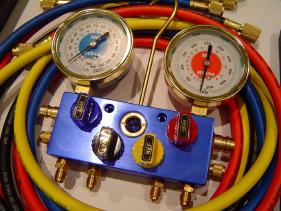When the air conditioning unit in a car stops blowing cool air, it may be time for an A/C recharge. To recharge the A/C in a car means adding more refrigerant to the system and correctly pressurizing it to allow the air to start blowing cold again. This car A/C repair does not take long or cost much to do as a DIY project, but it does require a bit of care and the right equipment. We’ll talk a little bit about how your car’s A/C works, signs that you might have a leak, and how to recharge the A/C system.
How a Car Air Conditioning System Works
An air conditioning system works by taking refrigerant and running it through a series of parts that use pressure to create temperature gradients.
The refrigerant is pumped through tubes by the compressor, which employs pressure to transform the liquid refrigerant into a gas. It is then sent to the condenser to release its heat into the atmosphere, turning back into a liquid and flowing to the evaporator, where it captures heat from the vehicle and disburses it into the air, cooling the refrigerant in the process. A fan near the passenger compartment blows cooled air around the cold refrigerant onto the occupants of the cabin, maximizing the comfort of the driver and passengers.
The refrigerant then flows back through hoses to start the process again. Air conditioning is a closed system because it is not exposed to the outside. Refrigerant, under normal circumstances, flows in an endless loop through the system for the life of the vehicle.
Or at least that’s how it’s supposed to work.
In real life, nothing is permanent. An A/C system endures high pressure, heating and cooling, and a compressor with moving parts to pump the gas through the system. Leaks can form at almost any point in the system and cause a loss of refrigerant.
When refrigerant leaks, it creates strain in the compressor and provides a decreasing amount of cool air. When the amount of refrigerant drops below the level necessary to cool the vehicle’s interior, the A/C begins blowing hot air.
Signs of an A/C Leak
If the car air conditioner is blowing hot air, this is a sign that the system is low on refrigerant. There are a number of possible reasons for this, but the most likely is a leak in the system. Before the car A/C system can be recharged, any leaks must be identified and repaired.
It is important to determine whether a leak is responsible for the A/C’s failure so it can be repaired prior to recharging the system. Here are three obvious symptoms of a refrigerant leak:
- You hear a funny sound from the A/C unit. The compressor “short cycles,” or stops and starts repeatedly when there is insufficient refrigerant to compress. Short cycling may sound like a thump, whir or clicking sound coming from beneath the hood. When this occurs, it is important to turn off the air conditioning until the problem is rectified with a leak repair and recharge.
- The warning light on the dashboard indicates an A/C malfunction. Dashboard warning lights are not always very informative, but they do provide an early alert that something is amiss. In this case, the operation of the vehicle is not at risk but the comfort of those inside it is. The most common causes of A/C failure are a refrigerant leak and a compressor malfunction. In either case, the air conditioning will require repair before long.
- The A/C blows hot air. At this point, the air conditioning system has failed, again most likely because of a leak or a problem with the compressor. There are many other reasons for A/C system failure, but those two should be explored first.
This is when it is time to repair the leak and recharge the system.
Repairing the leak chemically is an option you may want to explore if taking the vehicle in for service isn’t an option. Red Angel A/C Stop Leak is a great option and easily installs with the Red Angel Oil Injector. Red Angel A/C Stop Leak is activated by temperature differences at the leak point in the A/C system to seal most common leak points. The product is safe to use, only reacts once and unused product in the system acts as a superior lubricant.
Red Angel A/C Stop Leak is compatible with R-12 & R-134a refrigerant systems and can be added through an oil injector. The refrigerant itself can also be added through the injector as well.
Taking your car to an automotive care professional to repair the leak and recharge the system, which is the preferred method, will cost about $250-$500. The cost to recharge the A/C in a car runs between $150 and $300, but it should always be accompanied by a leak check, done with UV dye and a UV light. This adds another $150 or so.
How to Recharge the A/C in a Car
To recharge the A/C in a car, the following materials are necessary:
- A/C dispenser with trigger and low side gauge, like the Red Angel Oil Injector
- Refrigerant
- Safety glasses and gloves
- Owner’s manual
The amount of refrigerant is indicated in the vehicle’s owner’s manual and is usually 12-28 ounces. For example, a 2015 Toyota Camry requires 17 ounces of refrigerant while a 6-cylinder 2017 Ford F-150 takes 24 ounces.
Follow these simple 11 steps to add refrigerant and recharge the system:
- Determine whether the ambient air temperature is at least 55 degrees Fahrenheit. If it is below that, move to a warmer space or stop the process.
- Start the engine and turn the A/C on high.
- Determine whether the A/C compressor is engaging. Using extreme pressure, the compressor converts the liquid refrigerant to gas. Its clutch must spin when the A/C is on high. Determine whether the pulleys and belts attached to the compressor are moving. If the clutch is not engaging the compressor, either the compressor is not working or the refrigerant is close to empty. By adding refrigerant during the recharging process, the source of the problem can be determined.
- Determine the correct pressure. The refrigerant packaging should contain a chart outlining the correct pressure to charge the system at different air temperatures. Automobile manufacturers provide recommended A/C pressure in the owner’s manual, so check that as well. Recharging with the incorrect pressure can prevent the A/C system from operating efficiently.
- Test the pressure. Turn the vehicle off and locate the low side pressure port. It is commonly located on the passenger side of the engine bay. It sits on an aluminum pipe that emerges from the firewall between the passenger compartment and the engine, usually between the compressor and condenser. The low side pressure port will have a black cap on it with the letter “L”. It is the larger of two fittings.
- Attach the recharge hose from the recharge A/C kit. Attach the recharge hose by placing the fitting at the end of the recharge hose over the low side port and pushing down until it clicks into place. Refrigerant should never be added to the high side port because doing so could endanger the entire air conditioning system. Fortunately, the connector only fits the low-side port on most vehicles, rendering that mistake nearly impossible to make.
- Restart the vehicle. Again, with the A/C on maximum cooling, observe the gauge in the recharge kit. The pressure needs to be around 40 psi when fully charged, depending on the air temperature. At hotter temperatures, pressure as high as 55 psi may be necessary. Again, consult the repair manual.
- Add the refrigerant through the recharge hose. Follow the directions on the refrigerant package. Generally, the injector trigger must be squeezed for 10 seconds to add the refrigerant to the system. Once the pressure reaches 25 or 30 psi, the compressor clutch should engage. After releasing the trigger, check the pressure gauge to avoid overcharging the A/C system, which can cause permanent damage.
- Check that cool air is blowing. Lean into the passenger compartment and feel whether cool air is blowing out of the vent.
- Detach the hose. Leave the can of refrigerant attached to the charging hose while detaching. Store unused refrigerant in a cool, dry location.
- Affix the cap on the low side port. Check for cracks in the cap, or you may end up repeating this process in the not-too-distant future.
In the days following a full recharge of the car air conditioning, it may be wise to check the pressure to ensure that any leaks have been repaired.
An automobile does not require air conditioning to function. Only its occupants do, and even then, only during the hotter part of the year. For many Americans though, driving without a working A/C system is unthinkable. If that is you, address any problems with the system at the first sign of trouble.
BlueDevil Products can be found at AutoZone, Advance Auto Parts, O’Reilly Auto Parts, NAPA, Parts Authority, Auto Value, Bumper to Bumper and other major auto parts retailers.
BlueDevil Products can be found on Amazon.com or at AutoZone, Advance Auto Parts, O’Reilly Auto Parts, NAPA, and other major auto parts retailers.
Related Articles



